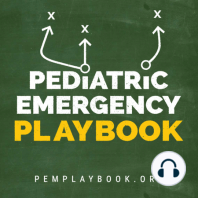47 min listen
Pediatric Elbow Injuries
ratings:
Length:
42 minutes
Released:
Nov 1, 2016
Format:
Podcast episode
Description
Johnny has fallen on an outstretched hand, and comes to you with a swollen, painful elbow. Position of comfort, analgesia, xrays, and now what? What am I seeing -- or not seeing -- here? First a refresher on radiographic anatomy of the elbow -- Images courtesy of Radioglypics (Open Access Radiology Education). Used with permission. Now that we have our adult anatomy reviewed, let's go through the development of the elbow in a child. We are all born with primary ossification centers -- the basic shapes of our long bones. Secondary ossification centers then develop around the ends of our long bones, and make interpretation of films in the context of suspected injury difficult. Elbow Interpretation Roadmap: CRITOE More pragmatic and utilitarian than a prosaic mnemonic, CRITOE helps us to remember the order of ossification of the pediatric elbow. Although children develop at different rates, the order of ossification is programmed into us. Images courtesy of Radiopaedia. Capitellum By age one, the capitellum ossifies. On the AP view, imagine a little white oval balloon floating in the darkness between the radius and the humerus. Radial Head By age three, the capitellum gets another little balloon to join the party. The radial head is a bony little balloon that floats just above the floor. If you see both little balloons floating on either ends of the space between the humerus and the radius – you know this child is about three years old. Internal Epicondyle By the age of five, the capitellum and radial head are no longer little floating balloons, but now taking on shapes that resemble what they will look like as an adult. By age five, you’ve grown out of balloons, and have moved on to Frisbees. The internal epicondyle (meaning the medial epicondyle) starts to ossify by age five – a little bony Frisbee. Trochlea By age seven, another little Frisbee flies around. On the AP view, the trochlea is superimposed on the humerus – if you look at the distal medial humerus, you’ll see the trochlea like a little oval Frisbee taking shape (see combined film below). Olecranon By age nine, the olecranon of the ulna is ossifying. In a nine year old, you’ll see a capitellum, radial head, internal epicondyle, trochlea, and olecranon. External Epidondyle By age 11, you start to ossify your external epicondyle (lateral epicondyle). Pediatric Elbow Films: Putting It All Together Watch this dynamic video by Dr Jeremy Jones from Radiopaedia: Fracture Saviors: Fat Pads and Drawn Lines These three things can save us: fat pads, the anterior humeral line, and the radiocapitellar line. Non-annotated images courtesy of Heidi Nunn. Normal anterior fat pad Sail sign: billowing hypodensity, indicating blood; sometimes the only (indirect) sign of an elbow fracture Posterior fat pad: always pathologic Radiocapitellar Line: anterior humeral line bisects the capitellum Baumann’s angle (carrying angle): Normal is 70 to 75 degrees. A difference between extremities of just 5 degrees or more is abnormal. Supracondylar fractures: Gartland Classification Compartment Syndrome Pain out of proportion to exam, paresthesias, pallor, poikilothermia, pulselessness, and paralysis The 6 Ps of compartment syndrome are not sensitive in children. The only thing that may alert you to increasing compartment pressures in children is an increasing need for analgesics. Volkmann's ischemic contracture Untreated compartment syndrome results in thrombosis, edema, ischemia, and disabling contracture. Other Elbow Injuries (Details in podcast audio) Lateral Condyle Fracture Medial Epicondyle Fracture Radial head and radial neck fractures Olecranon fractures Elbow dislocation Radial head subluxation (nursemaid’s elbow) Medial epicondylar apophysitis (Little leager’s elbow) Test your retention: check out this interactive post from the team at D
Released:
Nov 1, 2016
Format:
Podcast episode
Titles in the series (100)
Vomiting in the Young Child: Nothing or Nightmare: In the young child, vomiting is the great imitator: Gastrointestinal, Neurologic, Metabolic, Respiratory, Renal, Infectious, Endocrine, Toxin-related, even Behavioral. To help us organize, below is a review of can't-miss diagnoses by age. The... by Pediatric Emergency Playbook
